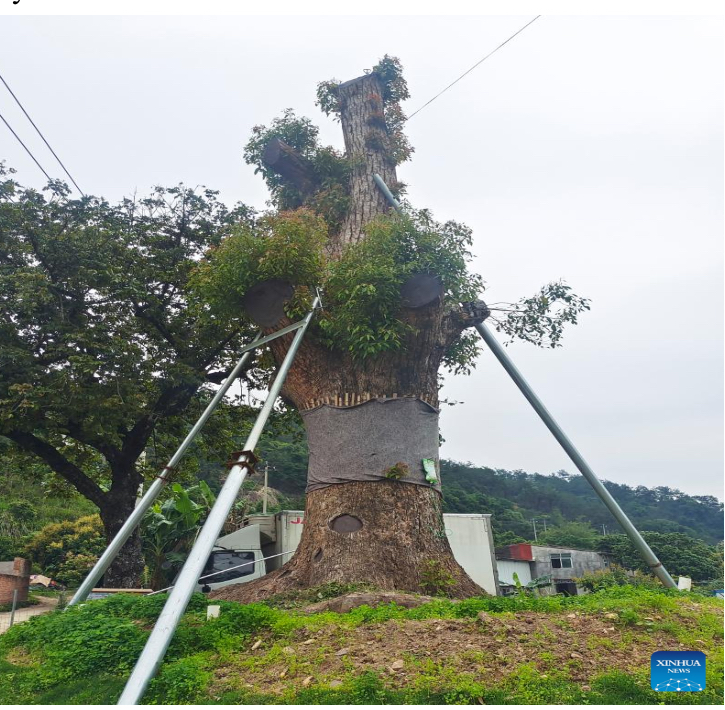By Gerald Mbanda

Photo of a century-old camphor tree in Fuzhou, southeast China’s Fujian Province. (Xinhua)
In recent decades, China has emerged not only as a global economic powerhouse but also as a committed steward of environmental protection. Among its many green initiatives, the nation’s deep investment in tree conservation and reforestation stands out as a symbol of its evolving ecological consciousness. For China, trees are not just natural resources—they are living symbols of harmony, growth, and resilience, cared for with the same dedication the nation offers its people.During my first visit to China in 2019, I witnessed how trees are given care and attention. Almost all young trees were painted at the trunk probably as a protection measure against being destroyed by termites. Secondly, most trees had some form of wooden or metallic cages that helped the tree to grow in a straight shape.
At the heart of China’s forestry efforts lies the Three-North Shelter Forest Program, often referred to as China’s “Great Green Wall.” Launched in 1978, this ambitious project aims to combat desertification by planting a massive belt of trees across the north, northwest, and northeast regions of the country. By the time the project is completed in 2050, it is expected to cover more than 4,500 kilometers, turning barren land into vibrant forest.
This ecological shield has already helped reduce sandstorms, stabilize the soil, and reclaim vast swaths of land from desertification. In many regions, local communities have been directly involved, creating a bond between people and the trees they help nurture and protect. Africa can learn a lot from China especially in arid regions in Sub-Saharan countries.
Beyond rural and desert landscapes, China is also leading the way in urban afforestation. Major cities like Beijing, Shanghai, and Shenzhen are actively integrating green spaces into their infrastructure. Rooftop gardens, vertical forests, and newly planted parks have become common sights, bringing cleaner air, shade, and beauty to the millions who live in these metropolises.
Urban tree-planting programs are often accompanied by public education campaigns that emphasize the role of trees in fighting climate change, reducing noise pollution, and enhancing mental well-being.
Recognizing that policy must support practice, China has implemented a range of laws and regulations to protect its forests. The Forest Law, updated in 2020, emphasizes sustainable forest management, mandates reforestation after logging, and imposes penalties for illegal deforestation. Additionally, China has introduced satellite monitoring and digital tools to track forest coverage and enforce compliance more effectively.
Tree planting has even become a civic responsibility in China. Since 1981, a national policy has encouraged citizens to plant trees as part of the “National Tree Planting Campaign”, which is seen as a patriotic duty. Every year, millions of Chinese citizens—students, workers, and officials alike—participate in tree-planting activities, often turning them into community events.

Trees with support poles to enable them grow straight in Jinhua, Zhejiang Province. Photo credit: @Gerald Mbanda
The sense of collective environmental stewardship in China, echoes the Confucian ideal of harmony between humanity and nature. In schools and workplaces, tree planting is not just encouraged—it’s celebrated.
China is also investing heavily in green technology to enhance its forest management. Drones, artificial intelligence, and big data are being used to assess forest health, track illegal logging, and plan optimal tree-planting locations. By embracing innovation, China ensures that its forests are not just preserved but intelligently cultivated for future generations.
China’s tree protection efforts extend beyond its borders. Through programs like the Belt and Road Initiative Green Development Coalition, China is helping developing countries combat deforestation and promote sustainable land use. Its experience in reforestation and forest management is increasingly seen as a model for nations facing similar environmental challenges.
In every tree planted, China expresses its dedication to a greener, more sustainable future. Much like the attention given to education, public health, and infrastructure, the care for forests is deeply woven into the national vision. As the country continues to develop, its respect and protection of trees serve as a powerful reminder that true progress must always be rooted in balance with nature.
 Africa -China Review Africa -China Cooperation and Transformation
Africa -China Review Africa -China Cooperation and Transformation
